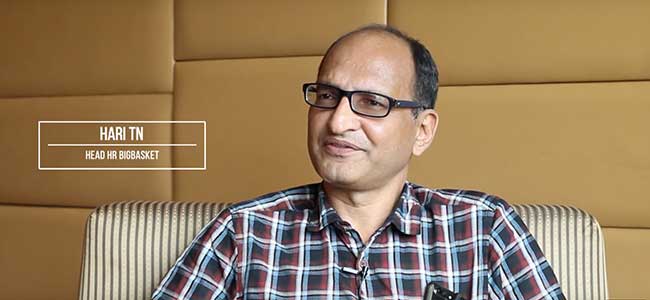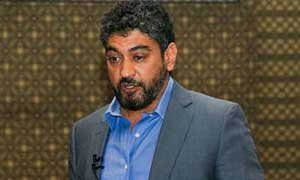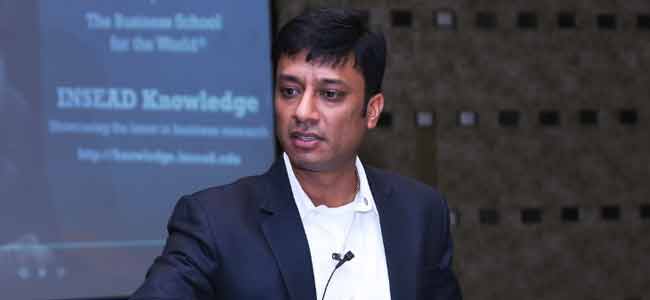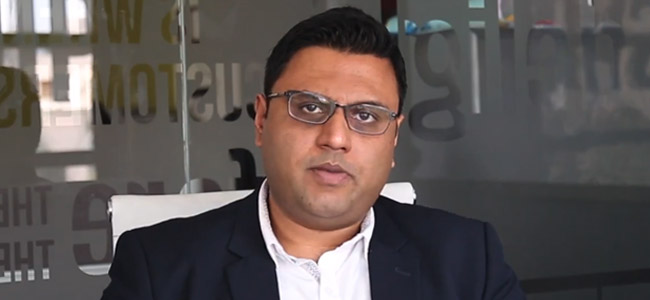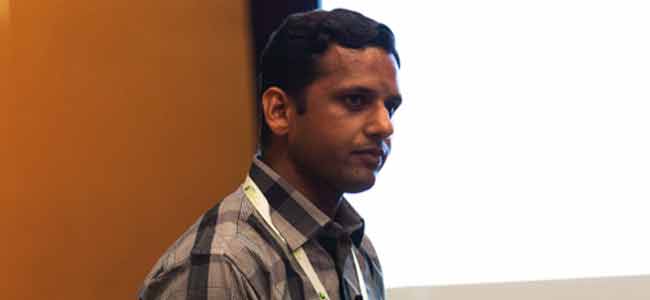India and Entrepreneurship - Tathagat Varma,
Founder & CEO, Thoughtleadership.in
About Tathaghat Varma
A quintessential knowledgepreneur, Tathaghat is passionate about people and products. He is the Founder and CEO of ThoughtLeadership.in, a boutique consulting and coaching firm with knowledge and learning-based leadership as its USP. Tathaghat is a mentor par excellence, a sought-after speaker, an avid and prolific blogger, and a faculty coach. He has built products in diverse hi-tech domains and is a volunteer with and holds membership at leading science societies, such as Senior Member of IEEE, Senior Member of ACM, and a Mensa Life Member for India. He has been recognized with several awards and honors in leadership, mentoring and innovation for his technical and professional contributions. Recently, he was chosen the Agile Leader of the Year 2015 by a jury led by KPMG at the inaugural India Agile Leader awards. He is a thought leader who has been the Chair at several leading science and technology conferences, a judge at Edison Awards and Edison Universe, Zinnov, and has to his credit numerous blogs and papers. He is a published APress author (book titled, “Agile Product Development: How to Design Innovative Products that Create Customer Value”) and has another book in the pipeline.
Thoughts on product industry in India today
The product industry in India has been maturing in the last two decades. I have been part of it and I can see that we are building more and more complex products from here. But, the most important and the most interesting development that has happened is we are building products from India for India. That’s very different from what we have done in the last few decades.
What goes into building a great product?
We are only beginning to realize it now what it takes to build a product and it’s very different
and much more that writing a few lines of code. We talk about understanding the users, we talk about
how do we create the delivery channels, we talk about what kind of pricing mechanisms are there, what
are the unique habits and preferences of Indians. That’s going to be humongously difficult for us simply
because we don’t have enough data points on that.
We are learning it, but that to me clearly separates that the technology is a given; everywhere it’s the
same technology, whether you’re on a cloud or on IoT or whatever you have. It’s the same thing
available. But, really understanding the products in terms of user preferences and what kind of unique
problem do we want to solve, what kind of user experiences do we want to deliver to our customers,
what kind of pricing mechanisms are there, and so on. These are the one that are user-facing, customer-
facing. Under the bonnet, the technology is a given which is not that much of a deal, in my view.
How have hiring strategies evolved in technology firms?
If I just take time shots and say what did we look for 15 or 20 years back, and what do we look
for in people now, the single biggest difference would be that 15 or 20 years, we were looking for people could follow the instructions, comply very well, deliver very well, because somebody from the mother ship sent us the product requirement or the software requirements and so on. What we needed were a set of people who could deliver on that. Today, if I go with that, I would break the mold and say that I want people who can think creatively. I don’t want people who are looking for compliance. I am looking for people who can think creatively. These are the people who can go out-of- the-box and they can say, ‘Ok, how do we solve a problem in a different manner? How can we even question the basic assumptions? Why are we even doing this in the first place?
I want people who are willing to think creatively, who are willing to think differently, who are willing to question the status quo and not simply come out with something just because there are 10 other products existing in the rest of the world, and let’s create another copy of that.
Can global products come out of India?
Look at our country. There is no dearth of meaningful problems. There is enough friction anywhere you go. If you can solve a problem for a billion people, you already have a global product, in my view. We have products for India being made in India, products like Hike, for example, which already has 100 million users. It is actually successful in India because it is solving the problems that Indian customers and users have in a very India-specific, unique manner, and not like someone who came from the left field and straightaway said, ‘Hey, this worked in Europe or in the US. So let’s solve the problem here. Let’s place people for that.’ The startup ecosystem is literally hitting a critical mass. In the next three years, it is projected that we are going to have more than 10,000 startups. We’re already the third largest startup ecosystem in the world and probably might become the second largest by the end of the year or so. In terms of the players that we need to have, whether it is investors, talent, markets, or whether it is the enablers in terms of coaches, mentors, trainers and so on, what will make us a product nation is solving those really complex problems in a very India-specific manner. In that process, we will uncover some ideas that will have a universal appeal. If we can solve a problem for a billion people, we can solve the problem for 7 billion people.
Your thoughts on the value of industry experience in startups.
The average age of entrepreneurs in India is 27; in the US it is 37; and in the UK, it is 47. The point I’m making here is that a lot of times we have an abundant amount of youth energy to get things going. But what we need to understand is that startup and entrepreneurship is not about just people who are 22 and 25 year-olds. In fact, people who have a deep experience in the industry (20 to 30 years) – just like in the US and the UK - they’re all coming together. The youth and the experience can come together because what they bring is so unique that a lot of entrepreneurs understand those things.
Why do you think industry practitioners as faculty at IPL works well?
A lot of colleges are pushing entrepreneurship in a big way. But as we already know, there is am big disconnect between academia and industry as it is, and with entrepreneurship impetus, this is only going worsen. So we need people who have been long enough in the industry to go back and help them. I have been associated with IPL for about 3-4 years now as a faculty. I have not only enjoyed delivering the sessions, I have learnt a lot from the classes also because the students are working professionals, and definitely very motivated about their personal improvement. It is a great experience because the average batch has an experience of 12-15 years. They bring so much value to the classroom that you can learn a lot from them, let alone the faculty. I do realize that it is a significant investment of time and effort - when you’re doing something for 15 months or so, your family hates you. I’ve been in those shoes myself when I did my Executive MBA. I know that situation.
Classroom, after working for many years, is tough. Your advice to PMs wondering if they can commit to a course like IPL.
May be you want to do some short-term courses just to see if you sat in a class last 10 years back. You still have that capacity and desire to really sit in the classroom, subject yourself to a lot of learning. It’s not an easy thing. Not all of us are cut out for that. It’s good to prepare yourself for that. There are so many courses available on the net. IPL itself offers an online course for 3 or 4 months – the ICPM - which can actually warm you a bit,. It is like wetting your feet before you take a plunge into the swimming pool. It gives you a preparatory step there.
Would you recommend the IPL learning curve for eager technology leaders?
Yeah. I think it is one of the unique courses globally – definitely, there is nothing like that in
India. I’m not saying that because I’ve been associated with IPL. It allows you to become a well-rounded
product leader. You could be coming from sales, or marketing, or technology, or any other background,
but you may not have the holistic understanding of what it takes to be a product leader. Over the 15 months, the faculty – the best part of the faculty in IPL is that these are not the people teaching from
the book - are these are people who use these tools and ideas in their day jobs. They are happy to come
and teach you over the weekend.
As we say in IPL, you learn over a weekend, and apply it. What you get is what has already been
practiced in the job.
Key Take-aways:
- In recent years, the product industry in India is seeing a shift to making more complex products for India in India.
- With technology being a given, the challenges to building a great product in India are comprehending users – their unique habits and preferences, creating delivery channels, and understanding pricing mechanisms.
- Global products coming out of India can be a reality. If a product made in India can work for a billion Indians and solve a problem, it can solve the problem for 7 billion people as well.
- Companies, today, are looking to hire people who can think creatively, out-of- the-box, challenge assumptions, question status quo, and willing to do things differently, not merely being able to comply and deliver.
- Industry practitioners as faculty plug the disconnect between academia and industry by bringing their invaluable practical experience into classrooms. It is time and effort well invested for working professionals to enroll into classroom courses handled by industry practitioners.
- IPL, as a recommended course for technology leaders, is an opportunity to develop holistic understanding to product leadership with industry-practitioner faculty enriching the learning curve.
Facebook
Twitter
LinkedIn
Related Videos
Tagged IPL TV- Leaders Take, LT-UX
